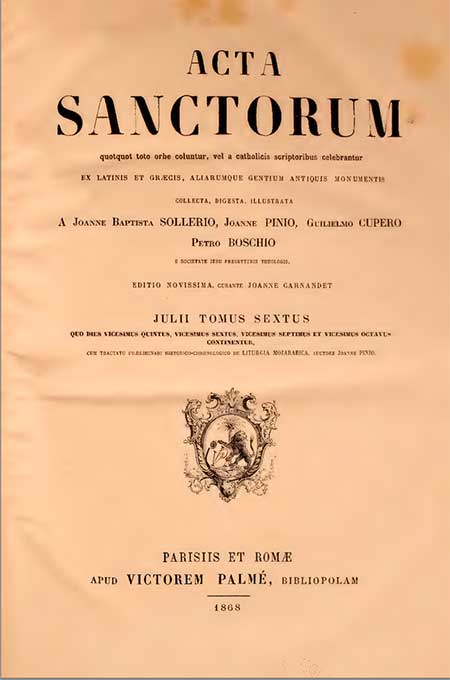A Trio of Martyr Saints Miraculously DISCOVERED in Bisceglie

[ABOVE: Acta Sanctorum printed many records of little-known saints]
Trajan was milder toward Christians than some other Roman emperors. Yet, near the end of his reign, three were martyred at Bisceglie (in southeastern Italy). Details are sparse. We do not know what charges led to their execution. Bishop Maurus, the foremost of the martyrs (whom tradition says was from Bethlehem), had guided the other two to faith—soldiers named Pantaleone and Sergius. A pious widow named Tecla de Fabiis interred their bodies near Sagina.
Centuries passed. No surviving documents mentioned the three martyrs during the next thousand years. Nonetheless in 1167, a number of impressive events lofted them to the status of wonder-working saints. Bishop Amando, who was consecrated bishop of Bisceglie on this day, 30 July 1154, reported the matter.*
According to the bishop, in the winter of 1166–1167 a “simple and religious” young man named Adeodonatus had a vision in which a magnificent apparition showed him where the martyrs reposed and commanded him to unearth the bodies. That the vision should have come to someone of low status did not surprise Amando. “God has chosen the weak things of the world to confound the strong,” he said, quoting Paul. Adeodonatus disregarded the dream and went about his duties. However, the visionary being reappeared, this time with fearsome aspect, and repeated his command. He promised the young man helpers.
On 10 May 1167, Adeodonatus, Dionysius (rector of the church of John the Evangelist at Sagina), and Walter (a holy man from Milan), disinterred the bodies. The bones lay in what appeared to be a ruined oratory, destroyed by Saracen invaders. Although 1,050 years had passed since the demise of the martyrs, a sweet odor emanated from their remains. Afraid that passersby, attracted by the delicious smell, would seize the relics, the three washed the bones and hid them in Sagina’s church. The following month, Bishop Amando and his retinue transferred them to the Church of Fortunatus in Bisceglie.
Amando declared that, although the skies were pouring down rain, not a drop touched the relics or their bearers during the move. Other signs followed. Smoke that smelled like spices came from the chest that held the remains. Teeth separated from the bodies revealed their locations by emanating a sweet odor. A bright light flared from the chest of bones.
Amando urged the city to construct appropriate reliquaries for the remains, and this was quickly done. In July the three saints were placed in a crypt in the cathedral of Bisceglie in a solemn and joyous ceremony attended by neighboring bishops or their representatives. Bisceglie's saints might not be famous, but they could work miracles just the same.
Amando recorded many cases in which the newly-minted saints intervened for those who petitioned them. A blind priest named Leo entreated the martyrs and received sight. William, another priest, was cured of paralysis that had immobilized one side of his body and left him unable to walk. A boy whose body had wasted away after a fall regained the use of his limbs.The deaf heard, the mute spoke, the blind saw, and the lame leaped for joy.
The cures seem to have been real, although some were expressed in terms that suggest they were incomplete. But what about the account of the discovery of the saints and the marvels that validated them? It raises red flags. To begin with, the story follows a traditional formula in which naive or innocent persons are given a vision that is quickly substantiated by miracles—a formula still perceptible centuries later in the accounts of Our Lady of Guadalupe and the Fatima apparitions. The only report comes from Amando. Did he have more to do with the events than he let on? Was civic pride at stake? Cities near Bisceglie had recently acquired saints. For Bisceglie to stand on an equal footing with its neighbors, it needed saints of its own, and then discovered them. These are are questions about which we wish we had more information.
-----------
*(Amando's account appears in “Historia Inventionis Primae Sancti Mauri, Pantalenonis et Sergii.” Acta Sanctorum for July vol. 6, 352–374.)





